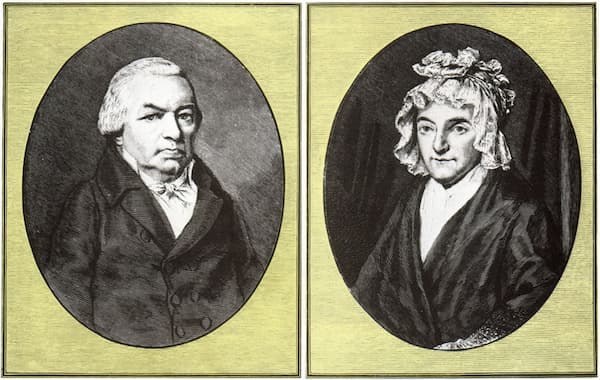I started the piano when I was five. My parents, both musicians, sensed I had talent because after my mother taught a piano lesson I would pick out the tunes with my pudgy little hands. But my first lessons were terrifying. My teacher had flash cards for all the sharps and flats, and pitches and rhythms. She wouldn’t let me start learning simple songs until I memorized them all.
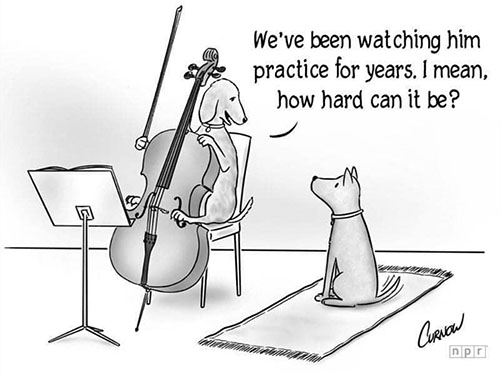
Those who’ve never tried to play an instrument imagine we talented musicians play music effortlessly. How hard can it be? Initially, we not only have to learn how to hold the instruments and position our arms and hands to coax out a decent sound, which is physically taxing, we all have to learn to read the music!
This involves music theory. What a task! Learning the key signatures, time signatures, the note values, rest values, and rhythms, the musical terms (often in multiple languages), as well as learning the clefs and note-reading… It’s like the study of any complex foreign language.
Squiggles and scribbles, which represent the tones and rhythms are written on a staff comprised of 5 leger lines.
Music lessons often begin on the piano. The treble clef, also named the G clef, twists around the leger line which is the note G. Similarly, the bass clef is sometimes called the F clef. The two dots to the right of the symbol are on either side of the leger line, which is the note F.
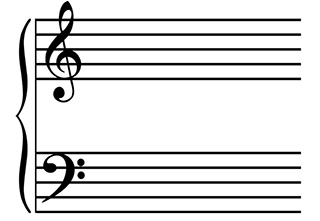
Some of us learned the treble and bass clef notes by rote, or by ear, (and mixed with copious tears); other musicians from all over the world learned them through fun anagrams or mnemonics.
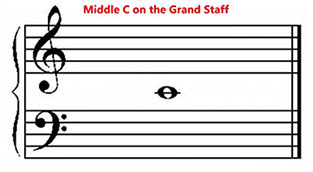
Middle C, so named as it is in the center of the piano keyboard, is written on a line between two staffs of 5 lines each. Every line or space above or below are named alphabetically from this C. Fortunately, there are only 12 to remember, and 12 possible keys: all the white and black keys of the piano—C, C# (or Db), D, D# (or Eb), E, F, F# (or Gb), G and G# (or Ab), A, A# (or Bb), B then it starts over with C. Simple, right?
But now comes the hard part. I’ll give you some hints, which we musicians love to use and laugh about.
The treble clef spaces do spell a word, (in English that is…) F-A-C-E. To learn the treble clef notes, which rest on the 5 lines of the staff E-G-B-D-F, I was taught a mnemonic, and I still remember it today: Every Good Boy Deserves Fudge!
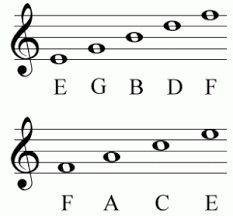
For the bass clef notes G-B-D-F-A I memorized: Good Boys Deserve Fudge Always!
The bass clef spaces A-C-E-G can never be forgotten if you remember: All Cows Eat Grass.
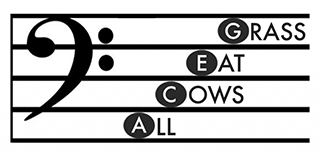
Too old fashioned?
Then learn these more modern interpretations—what a variety of silly sayings! E-G-B-D-F:
Empty Garbage Before Dad Flips
Every Grandad Breaks Dad’s Fence
Elvis’ Guitar Broke Down Friday
For bass clef lines G-B-D-F-A:
Great Big Dogs Fight Alligators
Gorillas Buy Donuts From Africa
Good Burritos Don’t Fall Apart
Great Britain Doesn’t Fight America
And the memorable sayings for the bass clef spaces A-C-E-G-B:
All Cars Eat Gas
Academic Crawfish Eat Grub Bugs
Learning the sharps and flats is another challenge! A sharp or hashtag raises a note ½ a step. A flat or b lowers a note one half step. If you encounter them in a piece they are immediately to the left of the note on the staff.
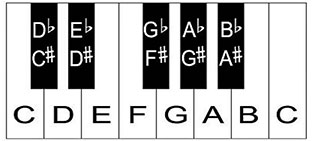
Musicians play in multiple keys or scale systems. To avoid repeatedly writing an accidental in front of every note, which would make a mess of the manuscript, we have a code or key signature, which is placed at the beginning of the line of the staff. The key signature tells us that every time you encounter certain notes in the key, they will be sharpened or flattened as the case may be. Of course, once you begin the piece you have to remember that key signature…
Britten: Simple Symphony, Op. 4 – Boisterous Bourree (Northern Sinfonia; Steuart Bedford, cond.)
Britten: Simple Symphony, Op. 4 – Playful Pizzacato (Northern Sinfonia; Steuart Bedford, cond.)
It’s really not complicated once you understand C major has no sharps or flats. From middle C we build each new key by counting 5 notes up, as exemplified by this chart of the Circle of Fifths.
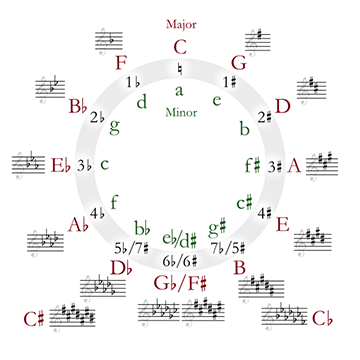
On the piano, C major would comprise only the white keys from C to C. For keys with sharps, we count up 5 notes; For example, from C, counting up 5, we come to G major, which has one sharp and that note turns out to be a black key on the piano. (It’s not quite so easy on a stringed instrument.) Counting up 5 notes more from G, we have D major, which has two sharps etc.
For flat keys, we count down 5 notes. Counting down 5 notes from C is F major, which has one flat. Counting down 5 from there we come to Bb major.
But we don’t all learn the keys that way. Some of us memorize comical but memorable sayings, such as this one I learned:
For the sharps, F-C-G-D-A-E-B:
Father Charles Goes Down And Ends Battle.
For the flats B-E-A-D-G-C-F:
Battle Ends And Down Goes Charles’ Father.
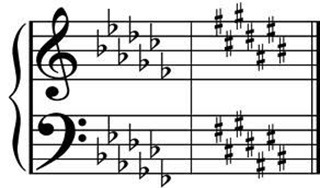
Fortunately, it helps that the first four flats spell the word BEAD, again in English. When you have to play in a key with more than four flats (or sharps for that matter) it becomes more and more difficult. Clearly, they should be illegal key signatures. (but they’re not!)
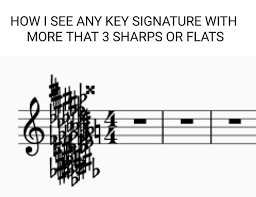
For more creative and contemporary sayings you teachers may like to adopt these:
For the sharps:
Father Christmas Gave Dad An Electric Blanket
For the flats:
Blanket Exploded And Dad Gets Cold Feet
More sharp perhaps:
Father Christmas Gave Derek An Empty Box
Fair Cinderella Goes Dancing At Every Ball
Fine China’s Glamour Declines After Every Break
Or the decisively modern flat take:
British European Airways Doesn’t Give Cheap Fares
If these don’t tickle your fancy, a quick survey of my colleagues indicated the aphorisms involve animals and food!
These are sharp:
Father Charles Goes Down And Eats Bacon
Fancy Catching Green Ducks After Eating Breakfast
Fat Cats Go Down Alleys Eating Birds
Getting raunchier:
Father Christmas Gets Diarrhea After Eating Biscuits
Fat Cats Get Diarrhea After Eating Bananas
(so sorry…)
Fat Cats Get Drunk After Every Beer
These may fall flat:
Birds Eat And Drink Growing Comfortably Fat
Brian Elliot Ate Delicious German Chocolate Fudge
English speakers are not the only ones who used these little adages. Here are a couple loosely translated.
In German:
Faule Bären Essen Aas Des Gestorbenen
(Lazy bears eat carrion of the deceased.)
Frische Brötchen Essen Asse Des Gesangsvereins
(Fresh rolls eat aces of the singing club)
In Finnish:
Fransiscus Bacon Estettin Astumasta Dessaun Gesslerin Seslonkiin
(Fransiscus Bacon was prevented from entering Dessau’s Gessler Seslon.)
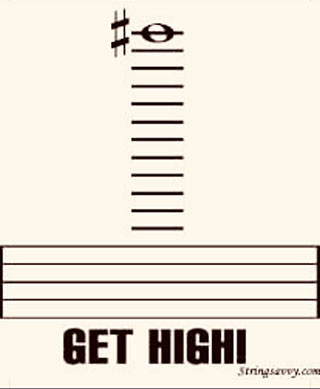
Voila! You know the lines and spaces, and the sharps and flats and you’ve just learned how to figure out what notes are on the page of the music in front of you. Several composers have written pieces for the beginner or amateur player from Beethoven to Britten. No worries if you have to name each note alphabetically to figure them out for a while. We all had to, and when leger lines go off the charts we still have to. What about the rhythms? Ah, now that’s another story!
For more of the best in classical music, sign up for our E-Newsletter



